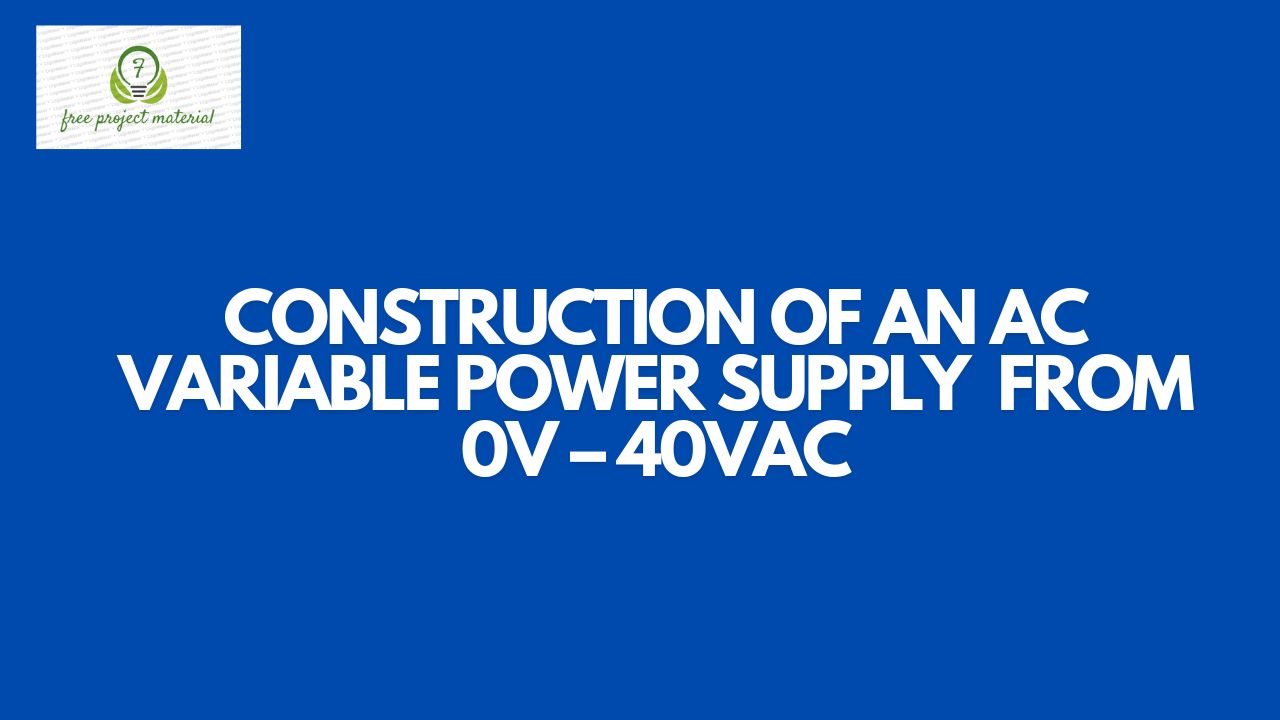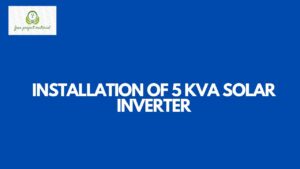ABSTRACT
A 0V – 40V regulated power supply is an electronic device that supplies regulated voltage of electric energy to an electrical load. The primary function of a power supply is to convert one form of electrical energy to another. A 0V – 40V regulated power supply takes in AC power from the mains supply and delivers and AC voltage to the item requiring power. To obtain variable voltages, we use an auto-transformer, portions of the same windings act as both the primary and secondary winding sides of taps where electrical connections are made. This auto-transformer works on the principle of “Faraday’s Law” of electro-magnetic induction”. Mutual induction between the winding is responsible for transmission action in a transformer. The voltage reduction capacity of auto-transformer depends on the turn ration of primary and secondary coil. As the number of winding in the secondary coil is less as compared to the number of winding in primary coil. So the amount of flux linkage to the secondary coil of transform will also be less compared to primary coil. This makes it possible for someone that runs different appliance of higher or lower voltage rating to operate without considering buying a new power supply.
LIST OF TABLES
Table Title
Table 4.1: List of materials and costing – – – –
LIST OF FIGURES
Figure Title
Figure 2.1 Step-up transformer diagram – – –
Figure 2.2 Step-down transformer diagram – – –
Figure 2.3 Auto-transformer diagram – – –
Figure 3.1 Block diagram – – –
Figure 3.2 Circuit Diagram – – – –
Figure 3.3 Auto-Transformer Design – – – –
Figure 3.4 Auto Transformer with Multiple Tapping – –
Figure 3.5 Main Primary Winding – – – – –
TABLE OF CONTENTS
Title Page
Certification – – – – – – –
Dedication – – – – – – –
Acknowledgement – – – – – – –
Abstract – – – – – – –
List of Tables – – – – – – –
List of Figures – – – – – – –
Table of Contents – – – – – – –
CHAPTER ONE
INTRODUCTION
1.1 Background of the Study – – – – –
1.2 Statement of the Problem – – – – –
1.3 Aim and Objective of the Study – – – – –
1.4 Significance of the Study – – – – –
1.5 Scope and Limitation of the Study- – – – – –
1.6 Organization of the Project – – – – – –
CHAPTER TWO
LITERATURE REVIEW
2.1 Historical background of Transformers – – –
2.2 Classification of Transformers – – – – –
2.2.1 Core Type and Shell Type of Transformers – – –
2.2.2 Power and Distribution Transformers – – –
2.3 Types of Transformers – – – – – –
2.3.1 Step Up Transformer – – – – – –
2.3.2 Step Down Transformer – – – – – –
2.3.3 Auto-Transformer – – – – – –
CHAPTER THREE
CONSTRUCTION METHODOLOGY
3.1 Material used – – – – – – – –
3.2 Block Diagram – – – – – – – –
3.3 Circuit Diagram – – – – – – –
3.4 Circuit Analysis and Principles of Operation – – – –
3.5 Construction Procedures – – – – – – –
CHAPTER FOUR
ANALYSIS AND TESTING
4.1 Performance Test – – – – – – –
4.2 Area of Application
4.3 Maintenance – – – – – – –
4.4 Bill of Engineering Measurement and Evaluation – – –
4.1.2 Precautions – – – – – – –
4.2 Testing – – – – – – – –
CHAPTER FIVE
FINDINGS, CONCLUSION AND RECOMMENDATIONS
5.1 Introduction – – – – – – –
5.2 Findings – – – – – – –
5.3 Conclusion – – – – – – –
5.4 Recommendations – – – – – –
References
Appendixes
CHAPTER ONE
INTRODUCTION
1.1 BACKGROUND OF THE STUDY
A power supply is an electrical device that supplies electrical energy to the load/machines. The primary function of a power supply is to convert one form of electrical energy to another and as a result, power supplies are sometimes referred to as electric power converters. Some power supplies are discrete stand-alone devices, whereas others are built into larger devices along with their loads.
Every power supply must obtain the energy it supplies to its load, as well as any energy it consumes while performing that task from an energy source. Depending on its design, a power supply may obtain energy transmission systems, energy storage devices such as batteries and fuel cells, electronically systems such as generators and alternators, solar power converters, or another power supply.
All power supplies have a power input, which received energy form the source and a power output that delivers energy to the load/external. In most power supplies the power input and output consist of electrical connectors or hardware circuit connections, though some power supplies employ wireless energy transfer in lieu (instead) of galvanic connections for the power input and output. Some power supplies have other types of inputs and output as well for functions such as external monitoring and control.
This project focuses on alternative current (AC) variable power supply. A variable power supply is one which includes some means for the user to easily adjust the output voltage and sometimes the current,. Adjustment is not most often accomplished with a potentiometer. This device takes AC as the input voltage to give a variables AC output, that, from 0 – 40volt AC.
1.2 STATEMENT OF THE PROBLEM
Electrical energy is useful for a number of things. Power supplies are one of the most popular types of electrical devices test equipment. It is important to analyze equipment that is exposed to under-and-over-voltage conditions when testing electronics which are power by the AC line.
When many heavy loads are simultaneously using the line, AC line voltage variations can exceed plus or minus ten percent (±), which is why designers often want to test beyond ordinary AC line voltage variations in order to account for potential stresses and to discover weakness. A variable Ac power supply is valuable in the situations.
Tapping the different voltages output from the power transformer gives difficulty and also selecting the require voltage to sure the same volt also was a big problem.
1.3 AIM OF THE PROJECT
The main aim of this project is to construct an AC variable power of supply ranges from 0V to 40V .
This device is designed to power a device with variable Ac output voltage of 0 to 40v ac, and the output is gotten by turning the voltage adjuster known as the potentiometer to a required voltage.
1.4 LIMITATION OF THE PROJECT
This device limited at producing 0 – 40v output using a potentiometer, rectifying diode and TLC 277 precision dual operational amplifier as the major components. It is not design to produce variable voltage above 40v AC.
1.5 SIGNIFICANCE OF THE PROJECT
This work makes it possible for someone to use power supply to run different devices of higher or lower voltage rating without considering buying a new or different power supply.
1.6 APPLICATION OF THE PROJECT
A variable power supply is a voltage regulator that an electrician and electrical project hobbyists use to test the capacity of voltage for any project they may have competed. The power supply is used as a gauge to make sure the piece of work the person has completed is able to withstand certain amounts of voltage and current load. Tests are generally conducted by applying different amounts of voltage to the piece of completed work a little at a time to ensure the stability of the circuit that has been created. These types of power supplies also are used by hobbyists to power small electronics requiring variables voltage and by tattoo artists to power tattooing guns.
By using such a variable supple of power, the individual is able to spot any temperaments or inconsistencies in the circuit he’s created in a manner that allows for adjustment to be made without having to scrap the entire project. A variable power supply is a useful tool for anyone who has many uses other than just testing.
In addition to being used to test circuits, this type of power supply may be used by miniature hobbyist as well. For example, such tools are commonly used by those who work in miniature electronic train sets. The power supply can be adjusted to either speed up or slow down the train as it is pushed around the track by the power of the completed circuit
1.7 SCOPE OF THE PROJECT
This is Ac variable power supply circuits that apply output of 0 – 40V by the use of electronic components such as bridge diode as main and other components as well as potentiometer. The output AC voltage can be adjusted by increasing or reducing between the bridge diode.
1.8 PROJECT WORK ORGANIZATION
The various stages involved in the development of the project have been properly put into five chapters to enhance comprehensive and concise reading. This project work is organized sequentially as follow:
Chapter One of this work is the introduction to the study. In this chapter, the background, significance, objectives, limitation and problem of this study were discussed.
Chapter Two is the literature review of the study. In this chapter, all the literature pertaining to this similar work was reviewed.
Chapter Three is conduction methodology. In this chapter all the method involved during the construction were discussed.
Chapter Four is the analysis and testing the system analysis and functionality test were carried out.
Chapter Five is on conclusion and recommendations.


